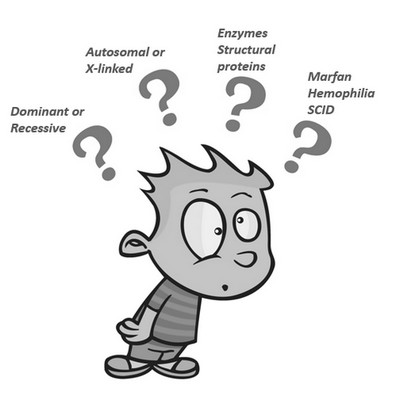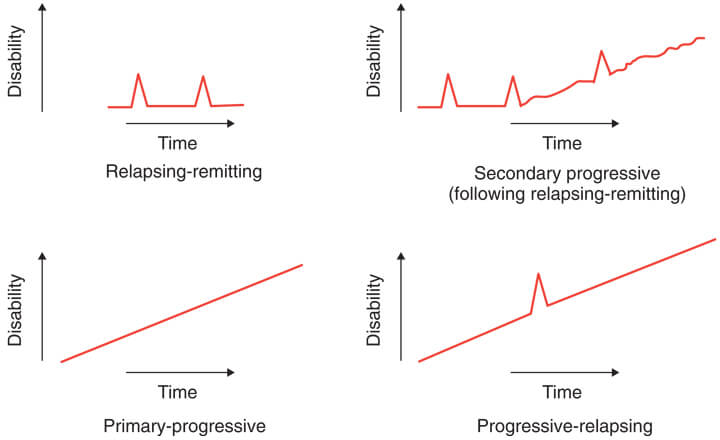Lets work with some generalizations
1. X-linked dominant, mitochondrial and Y-linked conditions are rare. You need to remember them.
2. Usually inherited in autosomal dominant pattern are:
- Mostly mutations in non-enzymatic structural proteins (e.g. collagen, fibrillin, cytoskeletal proteins of RBC) or in membrane receptors (e.g. LDL receptor)
- Diseases due to diminished feedback inhibition by end-product due to enzyme deficiencies e.g. Porphyria
- Except Congenital Erythropoietic Porphyria which is autosomal recessive
- Conditions prefixed “hereditary” or “familial”
- Hereditary cancer syndromes
- ‘Gain of function mutations’ like Achondroplasia, Huntington’s disease, Proto-oncogenes, etc.
3. Usually inherited in autosomal recessive pattern are:
- Most enzymatic defects and inborn errors of metabolism except few exceptions
- Transport proteins like globin or channel related mutations
- Exception: Copper transporting ATPase in Menke’s disease (X-linked recessive)
- Mutation in DNA repair genes like Ataxia Telangiectasia, Bloom Syndrome, Fanconi’s Anemia, Xeroderma Pigmentosum
- Exception: Hereditary Nonpolyposis Colon Cancer (HNPCC)
4. Usually inherited in X-linked recessive pattern are:
- Enzyme deficiencies that are exceptions from autosomal recessive pattern like Fabry’s disease, Phospoglycerate kinase 1 deficiency form of Glycogen storage disease, Hunter’s syndrome, G6PD deficiency, HGPRT deficiency, OTC deficiency
- Most of the inherited inmmunodeficiencies except:
- Autosomal recessive:
- ADA-SCID
- Chronic Granulomatous disease (some forms)
- Autosomal dominant:
- Job’s syndrome
- DiGeorge syndrome
- Autosomal recessive:
- Common forms of muscular dystrophies: DMD and BMD
X-linked dominant, mitochondrial and Y-linked conditions are rare. Since, these are limited in number compared to the other modes of inheritance that have hundreds and thousands of examples in the list, we will start with the examples of these disorders first.
Study the details of inheritance pattern and Mendel’s law.
X-linked Dominant
Mnemonic: FAIR
- Familial hypophosphatemic rickets (Vitamin D resistant rickets)
- PHEX gene mutation
- Fragile X syndrome
- FMR1 gene mutation
- Alport syndrome (most of the cases)
- COL4A gene mutation
- Incontinentia pigmenti
- IKK-gamma gene mutation
- Rett’s syndrome
- MeCP2 gene mutation
Y-linked Inheritance
- Swyer syndrome
- Mutation in SRY gene on Y chromosome
- Jacob’s syndrome
- Extra Y i.e XYY
- Auricular hypertrychosis
Mitochondrial Inheritance
- Leigh disease
- MELAS (Mitochondrial Encephalopathy, Lactic Acidosis and Stroke-like episodes)
- Leber’s Hereditary Optic Neuropathy (LHON)
- Myoclonic Epilepsy with Ragged Red Fibers (MERRF)
- Neuropathy, ataxia, retinitis pigmentosa, and ptosis (NARP)
Now, by exclusion let us learn the examples for other modes of inheritance.
Autosomal Dominant Inheritance
Key Idea:
- Most diseases caused by mutations in non-enzymatic structural proteins (e.g. collagen, fibrillin, cytoskeletal proteins of RBC) or in membrane receptors (e.g. LDL receptor)
- Uncommon forms of muscle dystrophy
- Diseases due to diminished feedback inhibition by end-product due to enzyme deficiencies e.g. Porphyria
- Conditions prefixed “hereditary” or “familial”
- Hereditary cancer syndromes
- Blue-yellow color blindness
These are characterized by:
- Reduced penetrance: individuals inherit the gene but can be phenotypically normal
- Variable expressibility: the trait is seen in the individuals carrying the mutant gene but is expressed differently among individuals, e.g. patients of neurofibromatosis have variant from brownish skin spots to multiple skin tumors in different patients.
- Gain of function e.g. Huntington’s disease or Loss of function (Dominant negative mutant allele) e.g. Collagen disorders (single mutant collagen chain and normal collagen trimers cannot be formed e.g., Osteogenesis imperfecta, Ehler Danlos, Marfan syndrome).
Examples:
- Achondroplasia
- Ehlers-Danlos Syndrome (most; type 6 is autosomal recessive) – type 3 (hpermobility type; most common), type 4 (vascular type; most dangerous)
- Facioscapulohumeral, Oculopharyngeal, Limb-girdle and Emery-Dreifuss muscular dystrophy
- Familial Adenomatous Polyposis
- Familial hypercholesterolemia (LDL receptor defect)
- Hereditary spherocytosis (Spectrin and ankyrin defect)
- Huntington disease
- Marfan syndrome (Mutation of fibrillin gene on 15q21)
- Myotonic dystrophy
- Neurofibromatosis type 1 and 2
- Porphyrias (except congenital erythropoietic porphyria which is autosomal recessive)
- Tuberous sclerosis
- Von Willebrond Disease except type III vWD (autosomal recessive)
Mnemonic: Autosomal DOMINANT Hunts Vulnerable Family.
- Autosomal – ADPKD
- D – Dystrophia myotonica
- O – Osteogenesis imperfecta
- M – Marfan syndrome
- I – Intermittent porphyria
- N – Neurofibromatosis type 1 (von Recklinghausen disease – more common 90%; Lisch nodules; Juvenile myelomonocytic leukemia; mutation of neurofibromin on chromosome 17)
- A – Achondroplasia
- N – Neurofibromatosis type 2 (less common 10%; bilateral acoustic neuromas, multiple meningioma; Lisch nodules absent; mutation of merlin on chromosome 22)
- T – Tuberous sclerosis
- Hunts – Huntington’s disease, Hereditary spherocytosis
- Vulnerable – vWD disease
- Family – Familial hypercholesterolemia
Autosomal Recessive Disorders
Idea:
- Most enzymatic defects and inborn errors of metabolism except few exceptions
- Transport proteins like globin, channel or cilia related mutations
- Mutation in DNA repair genes like Ataxia Telangiectasia, Bloom Syndrome, Fanconi’s Anemia, Xeroderma Pigmentosum
- Exception: Hereditary Nonpolyposis Colon Cancer (HNPCC) which is Autosomal Dominant.
- Congenital bleeding disorders except the common ones:
- Hemophilia A and B (X-linked recessive)
- Von Willebrond Disease Type 1 and Type 2 (Autosomal dominant)
- Wiskott-Aldrich syndrome (X-linked recessive)
Suspect uniparental disomy if affected child is born to one carrier and other normal parent.
Examples:
- Albinism (except ocular albinism which is X-linked recessive)
- ARPKD
- Ataxia Telangiectasia
- Barter syndrome
- Bloom syndrome
- Congenital adrenal hyperplasia
- Criggler Najar Syndrome (Severe form)
- Cystic fibrosis
- Dubin-Johnson Syndrome
- Familial Mediterranean fever
- Fanconi anemia
- Friedrich ataxia
- Galactosemia
- Glycogen storage disorders (except phosphoglycerate kinase 1 deficiency)
- Gilbert syndrome
- Gitelman syndrome
- Hartnup disease
- Hemochromatosis
- Homocystinuria
- Kartagener syndrome
- Laurence Moon Biedl Syndrome
- Leukocyte adhesion defect
- Mucopolysaccharidoses (except Hunter syndrome)
- Myeloperoxidase deficiency
- Pendred syndrome
- Phenylketonuria
- Rotor syndrome
- Sickle cell anemia
- Sphingolipidoses (except Fabry disease)
- Spinal muscular atrophies
- Usher syndrome
- Beta-thalassemia
- Wilson disease
- Xeroderma pigmentosum
- Ehler danlos type 6 (kyphoscoliosis type – mutation in lysyl hydroxylase)
Mnemonic: ABCDEFGH KLMNoP RSTuVWX
- Abetalipoproteinemia, Alkaptonuria, Albinism, Alpha-1-antitrypsin deficiency
- Bernard soulier syndrome, Bloom syndrome
- Carpenter syndrome, Chediak-Higashi syndrome, Cystic fibrosis, Criggler-Najar syndrome, CAH, Cystinuria, Cystinosis
- Dubin-Johnson syndrome
- Ehler Danlos syndrome type 6, Endocardial fibroelastosis
- Familial Mediterranean fever, Fanconi anemia, Freidrich’s ataxia
- Gaucher’s disease, Glanzmann’s thrombasthenia, Glycogen storage diseases, Gastroschisis
- Hartnup disease, Hemochromatosis, Homocystinuria
- Krabbe disease, Kartagener syndrome
- Leukocyte adhesion defect (LAD)
- Mucopolysaccharidoses (except Hunter syndrome which is X-linked), Muscular atrophy (SMA)
- Niemann-Pick disease
- Orotic aciduria
- Phenylketonuria
- Rotor syndrome
- Shwachman-Diamond syndrome, Sickle cell disease
- Tay-Sachs disease, Thalassemia
- Urofacial syndrome
- vWD disease type 3
- Wilson’s disease
- Xeroderma pigmentosum
X-linked Recessive Disorders
Idea:
- Enzyme deficiencies that are exceptions from autosomal recessive pattern like Fabry’s disease, Phospoglycerate kinase 1 deficiency form of Glycogen storage disease, Hunter’s syndrome, G6PD deficiency, HGPRT deficiency, OTC deficiency
- Most of the inherited inmmunodeficiencies except:
- Autosomal recessive:
- ADA-SCID
- Chronic Granulomatous disease (some forms)
- Autosomal dominant:
- Job’s syndrome
- DiGeorge syndrome
- Autosomal recessive:
- Common forms of muscular dystrophies: DMD and BMD
- Red-green color blindness
Examples:
The exceptions of Autosomal recessive disorders:
- Fabry’s disease
- G6PD deficiency
- Hunter syndrome
- Ornithine transcarbamylase deficiency
- Lesch-Nyhan syndrome (HGPRT deficiency)
Muscular dystrophies:
- Duchenne muscular dystrophy (DMD)
- Becker muscular dystrophy (BMD)
Others:
- Charcot-Marie-Tooth disease
- Wiskott-Aldrich syndrome
- Ocular albinism
- Bruton agammaglobulinemia
- Hemophilia A and B
- X-linked SCID
- Menke’s disease
- Red-green color blindness

He is the section editor of Orthopedics in Epomedicine. He searches for and share simpler ways to make complicated medical topics simple. He also loves writing poetry, listening and playing music. He is currently pursuing Fellowship in Hip, Pelvi-acetabulum and Arthroplasty at B&B Hospital.




For the first time in My life I could make out now which disease comes under which inheritance..thank you guys..
Thank you so much.
But I think in your last list, you meant the heading to be x linked recessive, rather than autosomal recessive.
Hi Osas,
These enzyme deficiencies are the exceptions from autosomal recessive disorders and hence, fall into the category of X-linked recessive disorders.
This topic was buggering my mind and finally I have learnt how to remember all of these. Bookmarked.